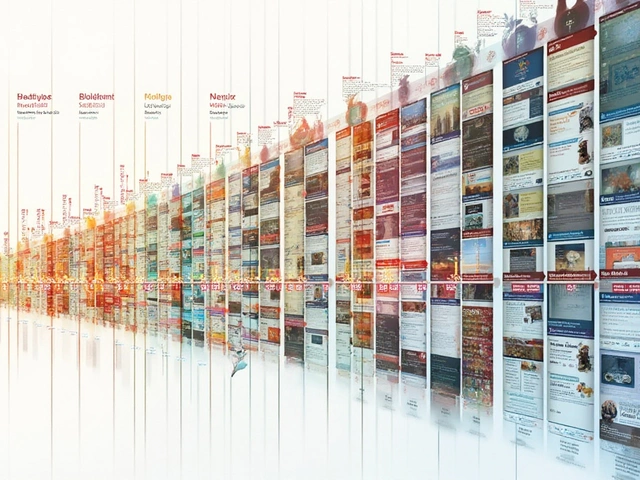
Do Blogs Make Money? The Real Truth About Blogging Income in 2025
Can you really make money blogging, or is it just wishful thinking? There’s a whole layer of hype and another of horror stories. Some claim six-figure monthly incomes, while others can’t even buy a coffee with what they earn online. Yet, the numbers don’t lie: there are active blogs raking in serious money in 2025. What separates those who cash in from those who don’t? It’s not luck. It’s a mix of strategy, grit, and yes, sometimes, timing. So, how much can you actually earn, and what does it take in today’s internet jungle?
How Do Blogs Actually Make Money?
Most folks are surprised when they find out that just tossing up a blog isn’t a money magnet. In the early days, a catchy topic or personal diary might grab attention, but that won’t pay the bills today. Real blog income starts once you tap into proven money-making channels. Advertising is the classic choice—Google AdSense still pays many bloggers in 2025, but the payout per click isn’t what it used to be. You need a serious amount of traffic, like tens of thousands of visitors a month, to see meaningful ad revenue.
Affiliate marketing is where things get interesting. Bloggers recommend products, include unique tracked links, and grab a commission if a reader buys. The trick? Recommending stuff people actually want—and trust you to suggest. For example, travel blogs score with hotel booking links, while tech blogs earn with gadget recommendations. There are also sponsored posts, where brands pay you to write about them or show their stuff. Rates vary wildly: a recent industry report found that lifestyle bloggers with 50,000 monthly page views earned anywhere from $100 to $2,000 per sponsored post.
Some write and sell their own ebooks, courses, or guides, turning knowledge into a product. Others create premium memberships, offering access to exclusive content. Subscription models are gaining traction as ad-blockers chip away at traditional ad income. For bloggers with a narrow niche or cult following, this is gold. You might see a knitting blogger charging $5 a month for insider patterns and live Q&As, and pulling in steady, loyal income.
Consulting and freelance gigs also come from blogging. A well-respected blog is a calling card: brands and other bloggers reach out, offering opportunities that pay way better than ad clicks. For many, the real payoff’s not from the blog itself—but from the doors it opens.
How Much Do Bloggers Really Earn?
If you’re hoping for a magic number, it’s a moving target. Some earn pennies, others pull in thousands every month. Let’s cut to the chase with some solid numbers. According to a recent survey of 1,500 bloggers (published in February 2025), here’s what they reported:
| Monthly Earnings (USD) | Percentage of Bloggers |
|---|---|
| Under $100 | 42% |
| $100 – $999 | 27% |
| $1,000 – $4,999 | 18% |
| $5,000 – $19,999 | 9% |
| $20,000+ | 4% |
Notice something? The majority don’t make much. That’s reality. The top earners treat their blogs as businesses, not hobbies. Their ‘secret’? Consistent posting, smart SEO, audience research, and testing what works. They also adapt—what worked in 2020 doesn’t always fly today. For example, food blogs used to dominate with display ads, but now they’ve pivoted to memberships, video classes, and even branded physical products.
Is it possible to quit your job and live off a blog? If you’re in that highest 4%—absolutely. But it usually takes years, not weeks. The dream of going viral overnight might happen, but it’s rarer than a unicorn spotting in Mumbai. Set your sights on earning side income first, and scale from there. Most top bloggers experimented and failed before they nailed a profitable formula. Persistence is underrated here.
Location also makes a difference. A blogger earning $1,000 in India or Indonesia stretches their dollars way further than someone in New York or London. That’s why many full-time bloggers choose to work from lower-cost countries, turning ‘average’ earnings into a comfortable living.

What Drives Blogging Income Higher?
Traffic isn’t the only key to making bank—it just unlocks the door. To raise your blogging income, you need to optimize everything. Here’s the stuff that truly moves the needle:
- Targeted niche: The narrower and more passionate your audience, the easier it is to sell to them. A general lifestyle blog gets lost in the shuffle, but a blog about vintage vinyl record collecting? That draws superfans.
- Email list: Google and Facebook can change their algorithms overnight, but if you have reader emails, you can always reach your audience directly. Newsletters sell products way better than random site visitors.
- Quality over quantity: One insanely helpful post can outrank fifty generic ones. Authority, trust, and depth win in SEO in 2025. Google’s latest update rewards honest content that demonstrates actual experience (think first-person stories, detailed tutorials, actual photos—not bland AI regurgitation).
- Multiple income streams: Don’t rely on just ads or one affiliate program. The top blogs juggle three to five revenue streams. If ad revenue tanks, affiliate sales or memberships can keep you afloat.
- Networking: Guest-posting, interviews, and collaborating with other creators open new doors—literally. More eyes on your work means more opportunity, especially for sponsorships.
Certain ‘evergreen’ topics almost always make money—think health, fitness, tech, finance. But there’s also huge potential in micro-niches if you’re creative about monetization. Ever heard of a blog dedicated just to building backyard pizza ovens? Those guys sell plans, courses, and branded gear. Passion plus a hungry crowd equals real earnings.
Common Myths About Blogging For Money (And Reality Checks)
The blogosphere is full of myths that keep people hopeful—or hold them back. Let’s bust a few:
- "You need millions of visitors to earn anything." Not true. Some bloggers with only a few thousand loyal visitors earn more than huge sites. It depends on how engaged your audience is (and whether your topic pays well—some niches have high-paying affiliate programs, others don’t).
- "Any blog can make money if you just write enough." Quantity doesn’t trump strategy. You could publish a new post every day and still see zero earnings if you aren’t targeting the right audience or monetizing smartly.
- "You have to be an expert writer." Most top bloggers started out average or even terrible at writing. What matters: telling stories, being relatable, and delivering real value.
- "Blogging is dead in the TikTok age." Nope. While video and social media swallow up time and attention, people still love reading blogs for in-depth guides, real research, and honest reviews. Tools like ChatGPT churn out bulk content, but real voices and authentic experiences still stand out—and earn.
- "You’ll get rich quickly." Making a living from a blog is closer to building a small business than buying a lottery ticket. Most who stick with it for 3+ years see much bigger returns than those who bail early.
Don’t fall for income screenshots or wild claims. The real test? Consistent work, adapting to what readers want, and being willing to shift strategy as times change. If you measure your success in baby steps and experiment like crazy, you give yourself a much better shot than just imitating what others say worked for them.

Smart Tips For Starting A Money-Making Blog In 2025
If the idea of earning from a blog has you jazzed up, you need a plan. Picking a niche you actually care about is still rule number one. Burnout comes quick if you don’t have real interest. But don’t stop at passion—research if the topic actually brings in money. Use tools like Ahrefs, SEMrush, or even free Google Trends to spot what’s buzzing and whether ad rates or commissions are worthwhile in your space.
Treat your blog like a business from day one. That means investing in a good, fast hosting provider (slow blogs get buried in search results), using a clean, mobile-friendly design, and tightening security. Don’t skip the legal stuff: clear privacy policies and cookie consent are mandatory if you want to work with major ad networks or affiliate programs in 2025.
Start building an email list early, even if you only have a handful of subscribers. Offer something useful as a freebie—think checklists, short guides, discount codes. This is your safety net if social media algorithms tank your reach.
Write as if you’re solving a real person’s problem, not just racking up word count. Include specific resources or personal hacks you’ve actually tried. Use conversational language and your own photos where possible—this is what makes readers stick (and come back).
Test every income approach, because what works this year might flop next. Don’t be afraid to reach out for sponsorships: brands love working with authentic small bloggers who really know their audience. And ring up fellow bloggers for advice—they’ve been through the wringer and most are happy to share what failed as well as what worked.
Most of all, accept that growth is slow. There’s literally no overnight success here, but every post adds up. Figures show that most monetized blogs crack $500/month after the first year if they stay consistent—far from life-changing, but proof you’re on the right road.
And here’s a real kicker: the do blogs pay money question has the same answer it did a decade ago—yes, if you’re real, persistent, and willing to keep learning. The real gold’s in marrying your own skills and story with what the world actually wants to read. Not everyone will make a fortune, but if you play it smart, your blog could pay you more than pocket change, and maybe even set you free from the nine-to-five.





Written by Arjun Mitra
I am an IT consultant with a keen interest in writing about the evolution of websites and blogs in India. My focus is on how digital spaces are reshaping content creation and consumption. I aim to provide insights and strategies for those looking to thrive in the digital landscape.
All posts: Arjun Mitra